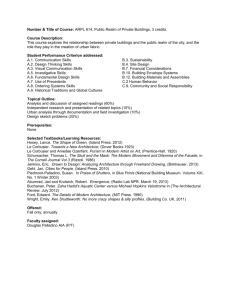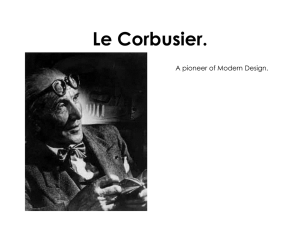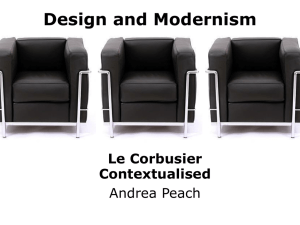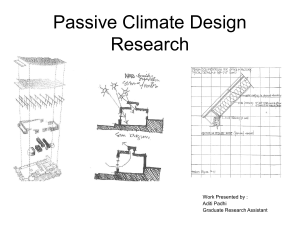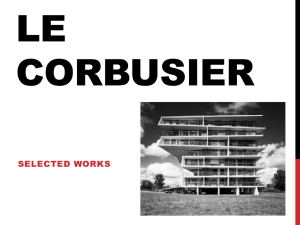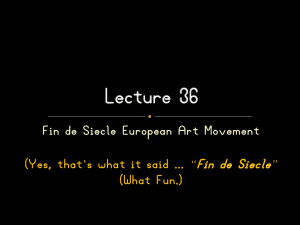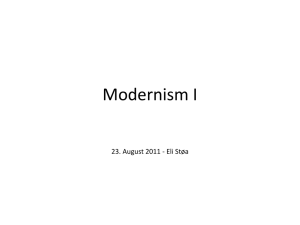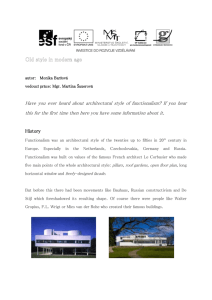The Giedions, Le Corbusier and Sculpture
advertisement
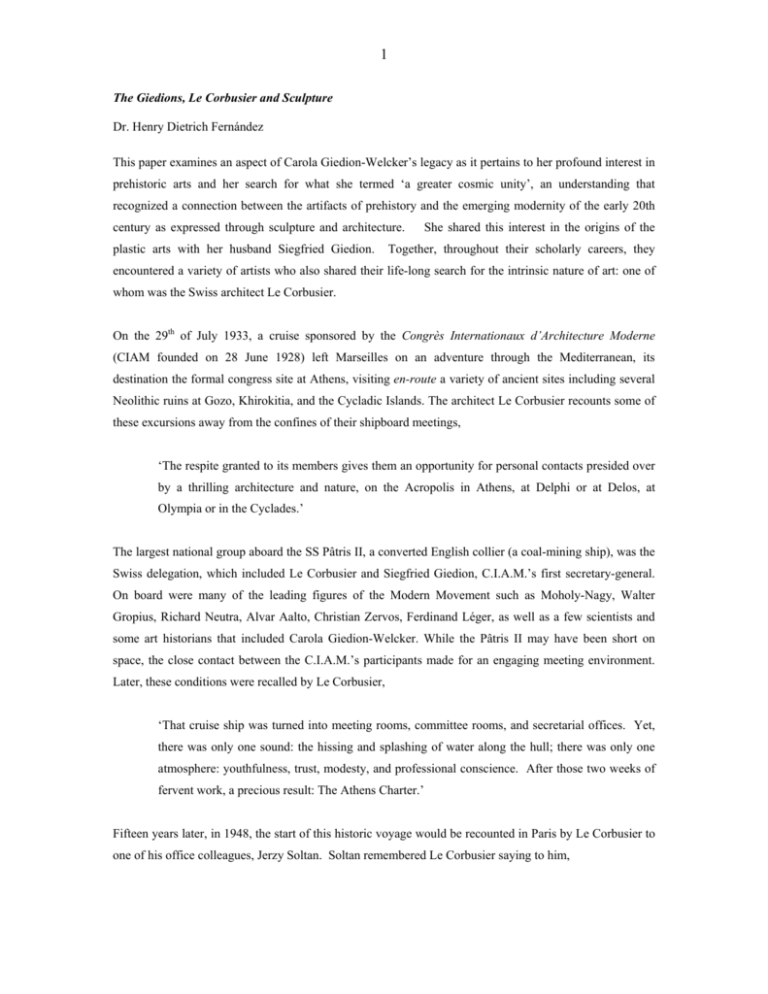
1 The Giedions, Le Corbusier and Sculpture Dr. Henry Dietrich Fernández This paper examines an aspect of Carola Giedion-Welcker’s legacy as it pertains to her profound interest in prehistoric arts and her search for what she termed ‘a greater cosmic unity’, an understanding that recognized a connection between the artifacts of prehistory and the emerging modernity of the early 20th century as expressed through sculpture and architecture. plastic arts with her husband Siegfried Giedion. She shared this interest in the origins of the Together, throughout their scholarly careers, they encountered a variety of artists who also shared their life-long search for the intrinsic nature of art: one of whom was the Swiss architect Le Corbusier. On the 29th of July 1933, a cruise sponsored by the Congrès Internationaux d’Architecture Moderne (CIAM founded on 28 June 1928) left Marseilles on an adventure through the Mediterranean, its destination the formal congress site at Athens, visiting en-route a variety of ancient sites including several Neolithic ruins at Gozo, Khirokitia, and the Cycladic Islands. The architect Le Corbusier recounts some of these excursions away from the confines of their shipboard meetings, ‘The respite granted to its members gives them an opportunity for personal contacts presided over by a thrilling architecture and nature, on the Acropolis in Athens, at Delphi or at Delos, at Olympia or in the Cyclades.’ The largest national group aboard the SS Pâtris II, a converted English collier (a coal-mining ship), was the Swiss delegation, which included Le Corbusier and Siegfried Giedion, C.I.A.M.’s first secretary-general. On board were many of the leading figures of the Modern Movement such as Moholy-Nagy, Walter Gropius, Richard Neutra, Alvar Aalto, Christian Zervos, Ferdinand Léger, as well as a few scientists and some art historians that included Carola Giedion-Welcker. While the Pâtris II may have been short on space, the close contact between the C.I.A.M.’s participants made for an engaging meeting environment. Later, these conditions were recalled by Le Corbusier, ‘That cruise ship was turned into meeting rooms, committee rooms, and secretarial offices. Yet, there was only one sound: the hissing and splashing of water along the hull; there was only one atmosphere: youthfulness, trust, modesty, and professional conscience. After those two weeks of fervent work, a precious result: The Athens Charter.’ Fifteen years later, in 1948, the start of this historic voyage would be recounted in Paris by Le Corbusier to one of his office colleagues, Jerzy Soltan. Soltan remembered Le Corbusier saying to him, 2 ‘In the heat of the summer of 1933 we launched ourselves into the ancient waters of the Mediterranean, like Ulysses on his odyssey.’ The friendship forged during the previous decade with the Giedions would now serve to whet their shared appetite for this knowledge of the Neolithic past. Le Corbusier’s relationship with Siegfried Giedion dated back to 1923 when they met in Paris, soon after the publication of Le Corbusier’s architectural manifesto, Vers Une Architecture. Subsequently, Le Corbusier would also meet Carola Giedion-Welcker. Their friendship was facilitated by their shared national homeland, Switzerland, and a deep mutual interest in an emerging modernism that encompassed all the arts and in part drew inspiration from ‘so-called’ primitive sources. Earlier, the publication of Le Corbusier and Ozenfant’s 1918 Après le cubisme and their 1920 Le Purisme had caught Carola Giedion-Welcker’s attention. Carola shared with Le Corbusier an interest in primary geometric shapes, the sphere, cube, and other prismatic shapes that had distinguished the primitive plastic arts for thousands of years. Six years later, in 1926 at the age of 33, Carola Giedion-Welcker’s interest in Le Corbusier’s ideas concerning the plastic qualities of modern painting was expressed in her review, Ozenfant und Jeanneret, ‘Moderne Malerei,’ a discourse that would be resumed in 1933 aboard the SS Pâtris II and especially whenever it docked near Neolithic sites. As mentioned, throughout the 1920’s the Giedions’ friendship with their Swiss compatriot evolved. In 1928, the C.I.A.M. was founded in Switzerland by Madame Hélène de Mandrot, Siegfried Giedion and Le Corbusier, an organisation that sought to divert architecture from academic preoccupations. While the C.I.A.M. organization was in the main an instrument for propagating avant-garde ideas in architecture and town planning, it also sustained a broader artistic agenda, one that was voiced by such figures as MoholyNagy, Walter Gropius and Carola Giedion-Welcker. It is important to emphasize that when Le Corbusier, embarked on the SS Pâtris II in 1933 he was not only traveling with a distinguished group of modernist designers and thinkers, but also with the Giedions, two scholarly friends who would prove invaluable in his search and investigation of the ancient origins of architecture. And conversely, Carola Giedion-Welcker’s insights into the origin of the plastic arts would be amplified through Le Corbusier’s understanding and sometimes misunderstanding of Neolithic archaeological remains. Moholy-Nagy also recalled that, as they steamed through the Mediterranean, Carola Giedion-Welcker’s special interests in sculpture and its primitive origins engaged the attention of many of the passengers aboard the Pâtris II, especially Leger and Le Corbusier. As recorded by her husband Siegfried Giedion, the excitement of examining the ancient sites, on the Island of Gozzo in Malta, Khirokitia in Cyprus and the 3 Island of Amorgos in the Cycladic Islands, sparked many discussions about the origins of painting, sculpture and architecture. Early in the voyage, the ship docked at Malta, a small archipelago of islands, south of Sicily. As anticipated, the Neolithic temples on Gozo held a special interest for the Giedions and Le Corbusier. Despite its fourth millennium B. C. date, it was here that Le Corbusier encountered an exotic Neolithic architecture that was intimately familiar in terms of its reductive geometric shapes. Upon viewing the trilithons, at Hagar Qim, Mnajdra and Ggantija for the first time, Le Corbusier is reported to have remarked on these ancient doorways, ‘I did this, I gave life to a stone doorway [trilithon] like this one in my youth at La-Chaux-deFonds. The man that made this door is my brother across time’ The Pâtris II continued on to Cyprus, on the eastern edge of the Mediterranean, forty miles from the coast of Asia Minor. As recounted by Carola and Siegfried, at Khirokitia on the island of Cyprus, members of the C.I.A.M. group visited a settlement of several hundred tholoi or circular domed huts. These Neolithic ruins, dating from c. 3,700 B. C., stirred a great excitement in Le Corbusier. Siegfried Giedion would later write: ‘The most interesting feature of the Khirokitia dwellings is their internal organization. They had an upper floor covering half the area of the ground floor. This division is still usual in the rectangular house plans of the Greek Islands, and Le Corbusier reintroduced the age-old principle in his Pavillon de l’Esprit Nouveau, Paris, 1925. When he [Le Corbusier] visited the Greek islands in 1933, together with several friends, he took out his tape measure, and I remember his delight when he found that the floor-to-ceiling heights of the houses (226 cm.) corresponded exactly to the dimension he liked to use and later incorporated in his Modular system.’ Similarly, later in Paris, Jerzy Soltan would recall many instances when dimensional and proportional aspects of the Neolithic remains at Khirokitia would come up in conversation as he worked with Le Corbusier in the development of the Modular system. Soltan felt that for Le Corbusier, recording a direct relationship with these fourth millennium ruins allowed him to connect to an architectural continuum, one that included Le Corbusier as an active participant in the timeless art of architecture. Together the Giedions and Le Corbusier, also explored the Island of Amorgos in the Cycladic Islands. Le Corbusier recalled going to Minoa, the ancient capital of the island, located on a high cliff above Katapola. ‘While only a few ruins remained from that ancient past, I saw what I needed to see, where King Minos ruled a second kingdom.’ 4 While some Neolithic artifacts and remains of the ancient Minoan civilization have been found at Amorgos, perhaps what interested Le Corbusier more was the location of a well known Neolithic marble Idol from Amorgos that he would have know from the Ancient Sculpture Collections at the Louvre Museum in Paris. As Carola Giedion-Welcker strolled across these sites with her husband Siegfried and their Swiss companion, Carola too would know that this was the locale of the same Cycladic Idol kept at the Louvre. Subsequently it would be included in her 1937 publication Modern Plastic Art: Elements of Reality, Volume and Disintegration. Furthermore, the 1955 revised and enlarged edition of Carola GiedionWelcker’s book, now renamed Contemporary Sculpture: An Evolution in Volume and Space, would feature two full pages dedicated to the plastic qualities of Le Corbusier’s works exhibited by his ‘Ozon 2’ (a painted carved wood sculpture), his 1952 ‘Unité d’ Habitation’ located at Marseilles, the port city where nineteen years earlier they had boarded the SS Pâtris II, as well as his design for his ‘Open Hand Monument’ (a sculptural work at Chandigarh, India). Her comment on the ‘Open Hand’ would apply equally to the Cycladic Idol: ‘Uncontaminated by functional intention, it emphasized the emotional origin and aim of what has been built by human hands for man.’ Carola Giedion-Welcker does include in Contemporary Sculpture, sculptural works by other architects, Vladimir Tatlin’s ‘Monument to the Third International’ and Luciano Baldessari’s built project for the Breda Works. However, their contribution consists only of a photograph, and a brief piece of text, in contrast to her detailed two-page spread on Le Corbusier. As has been shown, the C.I.A.M. sponsored voyage on the SS Pâtris II afforded rich exchanges between the passengers and especially between the Giedions and Le Corbusier. Their observations of ancient art and architecture, and two art historians’ and an architect’s subsequent reinterpretation and reinvention of them, allowed them to connect to the ancient past. Part of Le Corbusier’s search for a modern aesthetic, that would claim his place in the present and for the future while simultaneously claiming a connection with the deep Neolithic past, can be traced to this historic voyage. Additionally, these rich exchanges between the Giedions and Le Corbusier during the summer of 1933 would eventually find sculptural expression in the Swiss architect’s future architectural projects such as his Jaoul Houses (1952-54) in Paris and at Notre-Dame-du-Haut (1950-55) at Ronchamp. At Jaoul Le Corbusier would recover and employ such devices as the Catalan arch, and plant-covered roofs like ‘the ancient Etruscans,’ evoking a ‘Mediterranean vernacular’ a seemingly provincial architecture that would launch a new direction in architectural design 5 While the Jaoul Houses were under construction Le Corbusier was busy giving shape to another building, one at Ronchamp that would bring him world wide admiration, acclaim voiced by professionals and the general public alike. In his design for Notre-Dame-du-Haut at Ronchamp, Le Corbusier’s interest in eliciting a primal response through his use of curvilinear shapes and sculpted rough surface textures struck a chord throughout the global architectural community The highly strategised rusticity and the equally calculated geometry of Ronchamp are testaments to Le Corbusier’s skills and ingenuity in balancing the old and the new without compromising either one, but instead merging the two into a synthetic whole. It is exactly Le Corbusier’s talent for creating this convincing mixture that echoes the gravitas of the Neolithic past of the Mediterranean and the buoyancy of his l’esprit nouveau expressed in his late works, all qualities that were discussed with great passion with the Giedions during their 1933 excursion. The impact of the CIAM cruise, and his dialogue with the Giedions upon Le Corbusier’s ideas and work can also be seen in Le Corbusier’s own words. In July 1935, exactly two years after the Giedions and Le Corbusier’s voyage on the SS Pâtris II, le Corbusier would say with renewed confidence that, ‘Architecture alone is an instance of total plasticity. Architecture alone represents the medium for total lyricism. A total thought can be expressed through architecture. Architecture is self-sufficient. It is a genre that was created for expressing both through and in itself a whole cycle of emotions, the most intense of which stems from the influence of mathematics, where the play of plastic forms is symphonic.’ Moreover, the extent to which Carola Giedion-Welcker recognized that Le Corbusier shared her own vision of the place of sculpture across space and time is attested to by the extent to which she allows the artist to speak for himself in her book Contemporary Sculpture. She selects a quotation from his 1936 essay the ‘Tendencies of Architecture with the collaboration of Painting and Sculpture,’ which could be ascribed to any of his later works, again written in the aftermath of their Meditterranean voyage: Le Corbusier says, ‘Around the building, inside the building, there are definite places, mathematical points, which integrate the whole and which establish platforms from which the sound of speech would reverberate in all parts. These are the predestined sites for sculpture. And that sculpture would be neither a metope, a tympanum, nor a porch. It would be much more subtle and precise. The site 6 would be a place which would be like the focus of a parabola, or an ellipse, like the precise point of intersection of the different planes which compose the architecture.’ This ‘precise point of intersection’ was the element which Le Corbusier continuously sought to elucidate in his work, seeking to define an intersection between man, nature and the origins of art, and indeed the present and future of architecture. For him, as for Carola Giedion Welcker, ‘wider cosmic unity’ was a truth worth seeking.
